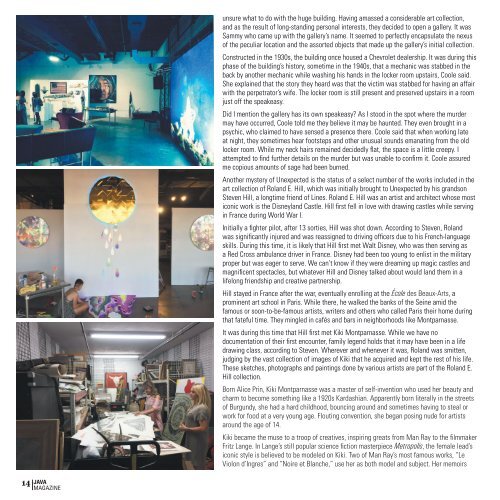Java.Sept.2017-1
You also want an ePaper? Increase the reach of your titles
YUMPU automatically turns print PDFs into web optimized ePapers that Google loves.
unsure what to do with the huge building. Having amassed a considerable art collection,<br />
and as the result of long-standing personal interests, they decided to open a gallery. It was<br />
Sammy who came up with the gallery’s name. It seemed to perfectly encapsulate the nexus<br />
of the peculiar location and the assorted objects that made up the gallery’s initial collection.<br />
Constructed in the 1930s, the building once housed a Chevrolet dealership. It was during this<br />
phase of the building’s history, sometime in the 1940s, that a mechanic was stabbed in the<br />
back by another mechanic while washing his hands in the locker room upstairs, Coole said.<br />
She explained that the story they heard was that the victim was stabbed for having an affair<br />
with the perpetrator’s wife. The locker room is still present and preserved upstairs in a room<br />
just off the speakeasy.<br />
Did I mention the gallery has its own speakeasy? As I stood in the spot where the murder<br />
may have occurred, Coole told me they believe it may be haunted. They even brought in a<br />
psychic, who claimed to have sensed a presence there. Coole said that when working late<br />
at night, they sometimes hear footsteps and other unusual sounds emanating from the old<br />
locker room. While my neck hairs remained decidedly flat, the space is a little creepy. I<br />
attempted to find further details on the murder but was unable to confirm it. Coole assured<br />
me copious amounts of sage had been burned.<br />
Another mystery of Unexpected is the status of a select number of the works included in the<br />
art collection of Roland E. Hill, which was initially brought to Unexpected by his grandson<br />
Steven Hill, a longtime friend of Lines. Roland E. Hill was an artist and architect whose most<br />
iconic work is the Disneyland Castle. Hill first fell in love with drawing castles while serving<br />
in France during World War I.<br />
Initially a fighter pilot, after 13 sorties, Hill was shot down. According to Steven, Roland<br />
was significantly injured and was reassigned to driving officers due to his French-language<br />
skills. During this time, it is likely that Hill first met Walt Disney, who was then serving as<br />
a Red Cross ambulance driver in France. Disney had been too young to enlist in the military<br />
proper but was eager to serve. We can’t know if they were dreaming up magic castles and<br />
magnificent spectacles, but whatever Hill and Disney talked about would land them in a<br />
lifelong friendship and creative partnership.<br />
Hill stayed in France after the war, eventually enrolling at the École des Beaux-Arts, a<br />
prominent art school in Paris. While there, he walked the banks of the Seine amid the<br />
famous or soon-to-be-famous artists, writers and others who called Paris their home during<br />
that fateful time. They mingled in cafés and bars in neighborhoods like Montparnasse.<br />
It was during this time that Hill first met Kiki Montparnasse. While we have no<br />
documentation of their first encounter, family legend holds that it may have been in a life<br />
drawing class, according to Steven. Wherever and whenever it was, Roland was smitten,<br />
judging by the vast collection of images of Kiki that he acquired and kept the rest of his life.<br />
These sketches, photographs and paintings done by various artists are part of the Roland E.<br />
Hill collection.<br />
Born Alice Prin, Kiki Montparnasse was a master of self-invention who used her beauty and<br />
charm to become something like a 1920s Kardashian. Apparently born literally in the streets<br />
of Burgundy, she had a hard childhood, bouncing around and sometimes having to steal or<br />
work for food at a very young age. Flouting convention, she began posing nude for artists<br />
around the age of 14.<br />
Kiki became the muse to a troop of creatives, inspiring greats from Man Ray to the filmmaker<br />
Fritz Lange. In Lange’s still popular science fiction masterpiece Metropolis, the female lead’s<br />
iconic style is believed to be modeled on Kiki. Two of Man Ray’s most famous works, “Le<br />
Violon d’Ingres” and “Noire et Blanche,” use her as both model and subject. Her memoirs<br />
14 JAVA<br />
MAGAZINE


















